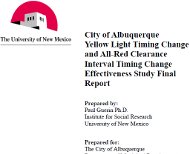Article from: www.thenewspaper.com/news/39/3971.asp
12/10/2012
New Mexico: Report Documents Benefit to Longer Yellows
University of New Mexico study finds accidents go down when red light cameras are removed and yellows are lengthened.
 The city of Albuquerque, New Mexico began scaling back its red light camera program in response to public pressure two years ago. Instead of operating cameras, city officials decided to apply a modest increase to the yellow signal duration at eighteen of the twenty intersections where cameras had previously been used. A report released in September found the change had produced a measurable benefit.
The city of Albuquerque, New Mexico began scaling back its red light camera program in response to public pressure two years ago. Instead of operating cameras, city officials decided to apply a modest increase to the yellow signal duration at eighteen of the twenty intersections where cameras had previously been used. A report released in September found the change had produced a measurable benefit.
The University of New Mexico (UNM) looked at 11 months of data before the timing change (during most of this time photo ticketing was operational) and after the timing increased. City officials told researchers only to use a basic comparison controlled for traffic volume as "sufficient" for this study. A more robust empirical Bayes analysis was not performed, but the researchers described the more thorough scientific research as supporting the hypothesis that longer yellows can have safety benefits.
"A study by Bonneson and Zimmerman (view report) on the effect of yellow light interval timing on the frequency of red light running at urban intersections found that an increase of 0.5 to 1.5 seconds in the yellow light interval (as long as the total time did not exceed 5.5 seconds) decreased red light running by 50 percent," the UNM report stated. "The authors also found that while drivers adjust to the yellow light interval, the increase in time did not 'undo' the benefit of an increased yellow interval."
In Albuquerque, the timing increase was generally between 0.2 and 0.5 seconds. One location, Jefferson and Paseo eastbound was actually shortened 0.2 seconds. The overall effect of the modest lengthening of the yellow time was an 8 percent reduction in crashes. Though not statistically significant, there was a fatal crash with camera enforcement and shorter yellows, but no fatalities occurred with longer yellows and no cameras. T-bone collisions dropped 18 percent.
UNM conducted a basic cost-benefit analysis using the Federal Highway Administration's method of assigning costs to certain types of accidents. Th university calculated the intersections with the slightly longer yellows experienced a $62,800 decrease in crash costs compared to a $122,800 increase in study intersections where the yellow signal was not changed and only the all-red interval increased.
"All the analyses support the finding that the combined yellow-light interval and all-red light interventions reduced property damage only crashes," the UNM report concluded. "The analyses of yellow-light interval intersections found that angle crashes were reduced."
Albuquerque voters rejected the use of red light cameras in a referendum last year. A copy of the UNM study is available in a 1.2mb PDF file at the source link below.
Source: Albuquerque Yellow Light Timing Change Effectiveness Study (University of New Mexico, 9/30/2012)
Permanent Link for this item
Return to Front Page
 The city of Albuquerque, New Mexico began scaling back its red light camera program in response to public pressure two years ago. Instead of operating cameras, city officials decided to apply a modest increase to the yellow signal duration at eighteen of the twenty intersections where cameras had previously been used. A report released in September found the change had produced a measurable benefit.
The city of Albuquerque, New Mexico began scaling back its red light camera program in response to public pressure two years ago. Instead of operating cameras, city officials decided to apply a modest increase to the yellow signal duration at eighteen of the twenty intersections where cameras had previously been used. A report released in September found the change had produced a measurable benefit.